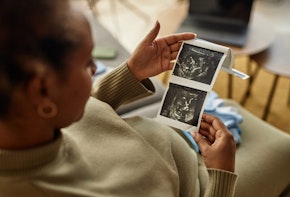In the United States, millions of women and other individuals who can become pregnant live in areas without access to abortion care and maternal health care.1 For decades, abortion care has been inaccessible for too many—people with low incomes, communities of color, people with disabilities, young people, and undocumented immigrants continue to face the greatest restrictions. Since the fall of Roe v. Wade, however, this crisis has worsened dramatically: 36 million women of reproductive age—more than 15 million of them women of color—now live in states where abortion is banned or likely to be banned.2 Access to quality maternity services are significantly constrained across the country, with the changing abortion landscape only constraining them further.3 States that restrict and ban abortion also have the worst maternal health outcomes and increasingly criminalize negative pregnancy outcomes such as miscarriage.4 As of 2021, approximately 12 percent of births occur in counties with limited or no access to maternal health care altogether.5 Even in places where care is technically available, if high-quality and culturally competent services are not covered by insurance then they are not actually accessible.
The United States stands as an outlier internationally as the only high-GDP country to see its maternal health outcomes worsen over recent years. The United States has the worst maternal mortality rate and the highest rate of avoidable deaths for women among high-GDP countries.6 Compared to its peer nations, women of reproductive age in the United States are more likely to forgo care because of costs, more likely to have difficulty paying medical bills, and less likely to have a regular source of care. Black and Indigenous people shoulder the greatest burden of these inequities, facing over twice the risk of death from pregnancy-related causes when compared to white women. This is due to discrimination in the health care system and in society writ large. Structural racism and other interlocking systems of discrimination fuel these stark racial disparities in the country’s abysmal maternal mortality and morbidity rates.7
Forty percent of all births in the United States are financed by Medicaid, but the percentage is higher for Black (64 percent) and Hispanic (58 percent) women and birthing people.
Medicaid presents a unique opportunity to advance health equity in reproductive and maternal health care. Medicaid is a critical safety net program that provides health coverage to people with low incomes. Black and Hispanic women and birthing people are disproportionately covered by Medicaid, as they are more likely to live on low incomes due to occupational segregation and vast racial and gender gaps in income and wealth.8 Forty percent of all births in the United States are financed by Medicaid, but the percentage is higher for Black (64 percent) and Hispanic (58 percent) women and birthing people.9 Medicaid providers and patients face obstacles that make it difficult to provide and access equitable care. This report discusses the barriers to Medicaid coverage of abortion, midwifery, and doula care. It describes how these barriers result from a failure to prioritize maternal and reproductive equity and proposes ways to center the needs of abortion providers, midwives, doulas, and their patients.
Misplaced Values
The devaluation of abortion, midwifery, and doula care in the U.S. health care system stretches back nearly two centuries, with roots in the historical exclusion of women—particularly Black women—from maternal health practice. More recently, the profit-driven nature of the U.S. health care system has perpetuated and exacerbated this exclusion by prioritizing profits over patient outcomes and equity.
Historic Harms
Our present day maternal and reproductive health inequities are the result of historical and ongoing racism and misogyny. Understanding the negative health outcomes experienced by Black and brown women and pregnant people in particular requires recognizing the dark history of obstetrics and gynecology in the United States.10 There are numerous historic harms that shape these people’s present-day experiences with the health system and resulting outcomes, such as the exploitation of enslaved women in the development of gynecological practices; the forced sterilization of Black women, Puerto Rican women, Indigenous women, and more recently, of incarcerated women; contraceptive coercion among low-income individuals; and hysterectomies performed without informed consent among detained immigrants.11
The holistic clinical care practiced by midwives and the patient-centered support provided by doulas and midwives offers a shift away from this dark history toward a model that centers patient autonomy. But over the past century, the medical establishment has relegated midwifery care to the margins of the U.S. health care system. Midwifery was explicitly excluded from the U.S. health care system as childbirth became increasingly medicalized Furthermore, Black midwives in particular faced systemic discrimination and exclusion that has resulted in a midwifery workforce that is now overwhelmingly white.12
Over the past century, the medical establishment has relegated midwifery care to the margins of the U.S. health care system.
The American Medical Association (AMA) was a driving force in the efforts to discredit midwives. The organization was formed in 1847 and became the professional organization and lobbying body for physicians. For decades, the AMA excluded Black people and women from becoming members and led efforts to gatekeep health care provision and “professionalize” medical care. The midwives that the AMA sought to replace provided a broad range of health services (particularly reproductive health services), including assisting with and providing abortion care. Furthermore, the AMA spearheaded efforts to criminalize abortion altogether.13 Up until the early 1800s, abortion was a widely practiced and accepted health service, but the AMA’s campaign helped usher in waves of laws outlawing the practice and paved the pathway for today’s landscape of fractured abortion access and the criminalization of patients and providers.
Prioritizing Profit over Outcomes and Equity
Some of the challenges in achieving equitable coverage for abortion, midwifery, and doula care reflect issues in the broader profit-driven U.S. health care system. Despite spending far more on health care than other nations, too many patients are left behind, experience negative health outcomes, and are drowning in debt from accessing the care they need.
Billing structures within Medicaid reflect the profit-driven focus of the fee-for-service health care system. The Center for Medicaid and Medicare Services (CMS) relies on relative value units (RVUs) to compensate providers for care. RVUs, however, reward volume of care rather than patient outcomes.14 When it comes to reproductive and maternal health care in particular, the care that patients need—and that brings the best outcomes—does not always align with the greatest profit. Low-cost interventions in maternal health (such as group prenatal care) have been shown to improve outcomes but are not incentivized under current payment models. There are efforts underway to shift to value-based payment, which would reimburse care providers based on the quality of care they provide, not the number of services or patients.
Medicaid Coverage of Abortion, Midwifery, and Doula Care: A Brief Overview
Important strides have been made to improve Medicaid’s coverage of reproductive and maternal health care. Research has shown that the Affordable Care Act’s (ACA) Medicaid Expansion led to increases in Medicaid enrollment among women of reproductive age. Forty-one states and Washington, D.C. expanded Medicaid, extending coverage to individuals who were long left behind.15 Before the passage of the ACA, more than half of women whose deliveries were covered by Medicaid lost their health coverage in the months after childbirth. Medicaid expansion not only enabled more women to access coverage, but it also guaranteed better continuity of coverage. Additionally, research has shown that Medicaid expansion is related to decreases in closures of hospitals and obstetric units.16 This research illustrates that Medicaid expansion has the direct benefit of providing health coverage to those who would otherwise not have it and the indirect benefit of supporting the operations of medical facilities. This is critically important given the ongoing issue of hospital mergers and closures.17
Despite these benefits, challenges remain. Insurers have always siloed reproductive and maternal health care from “regular” health care, and Medicaid is no exception.18 Furthermore, there is variability in the care available to Medicaid enrollees, particularly as it relates to abortion coverage and Medicaid reimbursement (or lack thereof) for midwives and doulas.
Abortion Care
The stigma surrounding abortion care and its exclusion from the U.S. health insurance system is a prime example of the historical and ongoing devaluing much of reproductive and maternal care.19 The Hyde Amendment—a budget rider that has been included in federal appropriations bills continuously since 1976—prohibits federal funds from being used to pay for abortion care, except in very limited circumstances.20 As a result, even before the Dobbs decision eliminated the federal right to abortion, this procedure was de-facto banned for Medicaid enrollees who could not afford the out-of-pocket costs or who couldn’t secure financial assistance from family, friends, or abortion funds.21 States have the ability to use their own funds to pay for medically necessary abortions, and seventeen states provide coverage for abortion care for Medicaid beneficiaries.22 In the states that do not allow this coverage, low-income women are left with few options. And in states that have not expanded Medicaid, many women are left in a coverage gap and lack insurance all together for any health care needs.
The stigma surrounding abortion care and its exclusion from the U.S. health insurance system is a prime example of the historical and ongoing devaluing much of reproductive and maternal care.
While this report focuses specifically on Medicaid, it is important to note the exclusion of abortion coverage is not limited to government programs. As of 2024, ten states have laws that prevent private insurers from restricting coverage of abortion in private plans while twenty-five states prohibit health plans on the ACA marketplace from covering abortion care.23
Midwifery Care
Midwives are trained birth workers that provide care to patients during pregnancy, labor, and postpartum. In the United States, the majority of midwives are certified nurse-midwives (CNMs) or certified midwives (CMs). Depending on the level of training and local regulations, midwives may assist births in hospital settings alongside physicians or at birth centers without a physician present. Although midwifery services have been demonstrated to improve outcomes and are cost-effective, many state Medicaid programs do not cover their services or reimburse their care at rates that are sustainable for providers.24 Payment for midwifery care varies by state and by licensure, and barriers remain for midwives and Medicaid patients. In twenty states, midwives are reimbursed by Medicaid at rates lower than physicians.25 Medicaid patients are also less likely than privately insured patients to have access to birth centers, where midwives typically practice.26 Crucially, the very nature of the midwifery model—a holistic approach with longer and more frequent visits than physician-led care—leads to insufficient reimbursement under existing Medicaid billing policies.27
Doula Care
Doulas are trained to offer nonclinical support during pregnancy, birth, and postpartum. Doula care can include support of the full range of pregnancy outcomes, including support for abortion patients. Similar to findings on midwifery care, doula services have been demonstrated to improve outcomes and be more cost-effective than “traditional” care.28 While more and more states are moving to cover doula care for Medicaid enrollees (over half of states are either currently reimbursing for doula care, implementing coverage, or taking related action), major obstacles remain.29 Even in states that reimburse for care, providers face insufficient reimbursement rates and billing procedures that are difficult to navigate.
Abortion, midwifery, and doula care are critically important to health equity and reproductive autonomy, but are undervalued by the U.S. health care system—a system that currently puts profit before equity.
Barriers for Medicaid Providers and Patients
The systemic devaluing of abortion, midwifery, and doula services has created barriers to providing equitable health care to Medicaid enrollees. Even when Medicaid allows for reimbursement for these types of care, obstacles still exist. TCF spoke with midwives, doulas, abortion providers, and advocates to understand the full range of barriers that cut across provider types.30 They cited low reimbursement rates and problems engaging with Medicaid’s billing process as the greatest challenges.
Low Reimbursement Rates
As mentioned above, insufficient reimbursement rates too often make providing care to Medicaid enrollees unsustainable. Midwives, doulas, and abortion providers are reimbursed at lower levels from Medicaid than from private insurance. Among provider types, midwives are reimbursed at rates lower than physicians for the same services. And doula care is only now becoming eligible for Medicaid reimbursement in certain states, though most of those states’ reimbursement rates are too low to provide a living wage. Reimbursement for abortion care—in the states and circumstances in which it is paid for with Medicaid—is also often inadequate and varies widely among states.31 Illinois is one example where advocates successfully increased Medicaid reimbursement rates—the result of a multiple years-long effort to better align rates with the care being provided.32 In most states, and in the cases where federal funds reimburse for Hyde-eligible care, reimbursement rates do not reflect the reality of abortion care. For midwives, doulas, and abortion providers, Medicaid rates too often place providers in a situation where they lose money providing care to Medicaid enrollees. This makes it especially difficult for women of color practitioners—already experiencing gaps in wages and wealth—to provide abortion care to patients while also caring for their own families.
Onerous and Opaque Billing Processes
Beyond the payment amounts themselves, the administrative task of Medicaid billing can be onerous—especially for independent and community-based providers. Providers must navigate burdensome processes and billing, dealing with codes that have been retrofitted for these specific types of care. Managed care organizations (MCOs) have additional issues of their own, including a lack of transparency about coverage and rates, leaving providers without clarity around what is covered and creating confusion between fee-for-service (FFS) and MCOs.
Barriers that community-based providers face enrolling in and navigating Medicaid limits provider options for patients in those communities.
These barriers are a particularly heavy burden for smaller providers who often come from, and serve, communities facing the greatest inequities. When providers and patients have shared identities—such as race or gender—it results in better communication and outcomes. Unfortunately, barriers that community-based providers face enrolling in and navigating Medicaid limits provider options for patients in those communities. When practitioners have a difficult time participating in Medicaid—or cannot participate at all—it ultimately limits the number and quality of providers available to enrollees. As a result, patients can experience longer wait times, delayed or foregone care, and subsequent worsened health outcomes.
What Can Be Done?
Achieving equity in maternal health care broadly—and abortion specifically—requires a complete reorientation of how our society values and respects these types of care and the providers who deliver them. There are a number of critical steps that policymakers and health care administrators must take to build a health care system that centers those values. Overall, incentives need to shift so that all health care plans are held accountable for ensuring equity and accountability, and guaranteeing full coverage of the full range of reproductive health services, including abortion, midwifery, and doula services.
Critically, Black women must be centered in these efforts. Other attempts to improve circumstances for patients and health care workers have failed or fallen short because they have failed to center Black women.33 As the Black Mamas Matter Alliance (BMMA) wrote: “Although federal, state, and local governments have attempted to address these issues, their solutions have largely failed to center the Black maternal, reproductive, and perinatal workforce and, instead, default to supporting white-dominated, perinatal and maternal health entities.”34 In its 2023 policy agenda, BMMA described the numerous policy efforts that, while well intentioned, have not achieved their intended goals. Many bills at the federal and state level have aimed to expand access to education and care, but have fallen short by excluding licensed and lay midwives, failing to address barriers to accrediting and operating birth centers, and ignoring the impact of structural racism and sexism. State and local efforts to reimburse doulas have been stymied by low reimbursement rates and exclusions to community-based models of care.
There are specific steps that should be taken to ensure that Medicaid ensures inclusive and equitable care.
Expanding Medicaid Coverage of Abortion
- Refrain from putting any limitations on abortion coverage in insurance plans. Six states across the country do not have any limits on insurance providers—private insurance, state Marketplaces, and Medicaid programs—covering abortion.35
- Require abortion coverage in private, Marketplace, and Medicaid plans. Ten states across the country currently have such requirements, nine of which require no cost-sharing for abortion coverage.36
- Go beyond insurance coverage. For example, Medicaid enrollees in California are guaranteed abortion care with no copayments or cost sharing, and medical justification requirements are prohibited.37 The state Medicaid plan also covers transportation and doula care.
Expanding Medicaid Coverage of Doula Care
- Increase reimbursement rates. In many states the Medicaid reimbursement rate for doula care is so low it disincentivizes doulas from participating in the program. Some states are in the process of raising reimbursement rates but many have yet to establish such a program.38
- Address training and credentialing burden. The rules for training and credentialing were established decades ago in ways that intentionally excluded community-based midwives. It is important that states take steps to protect and expand licensure for all midwifery designations, including Certified Nurse Midwives, Certified Professional Midwives, Certified Midwives, Licensed Midwives, and Lay Midwives, including traditional midwives, granny (grand) midwives, traditional birth attendants, and independent midwives. Three dozen states across the country currently allow certified professional midwives to practice.39
- Establish demonstration projects. Demonstration projects should be utilized to test payment models under Medicaid and the Children’s Health Insurance Program (CHIP) for maternity care, including postpartum care.40
Expanding Medicaid Coverage of Midwifery Care
- Increase access to birth centers. States can expand midwifery licensure and access, establish Medicaid reimbursement at living wages, and eliminate barriers, such as certificate of need, physician supervision, and collaborative agreement requirements.
- Develop home birth infrastructure. States can support home birth by establishing and enhancing public education about home birth practices, integrating home birth services into their health system, and expanding midwifery licensure and access.
- Eliminate maternity care deserts. States can make maternity care more plentiful by expanding midwifery licensure and access, scaling up telehealth systems, and implementing perinatal regionalization, a systems-based model of care.41
Improving Medicaid Coverage of Maternal Health Care
- Expand telehealth. As outlined in the Tech to Save Moms Act, the Center for Medicare and Medicaid Innovation should explore models that improve the integration of telehealth services in maternal health care.42
- Expand home visiting programs. The Maternal, Infant, Early Childhood Home Visiting (MIECHV) program should include community-based organizations that are Black-led and centered and birth and reproductive justice informed in their state-funded home visiting programs. These organizations should also be approved as Medicaid certified doula programs.43
- Improve access to maternal mental health services. States can improve access by increasing the number of mental health providers participating in Medicaid and other public and private insurance programs, increasing reimbursement rates, and covering nontraditional, alternative behavioral health therapies such as meditation or art therapy.44
- Improve continuity of coverage for pregnant and postpartum people. There a number of policy changes that should be adopted to ensure continuity of coverage, including presumptive eligibility for Medicaid/CHIP during application processing, automatic re-enrollment in Medicaid/CHIP for eligible birthing people after pregnancy, and taking steps to prevent any disruptions in coverage from the beginning of pregnancy through one year postpartum.45
- Ensure equitable payment and reimbursement rates. Medicaid should guarantee midwives receive equitable pay and should eliminate administrative burdens, payment delays, and unnecessary surveillance.46
Notes
- Katherine Gallagher Robbins, Shaina Goodman, and Josia Kelin, “State Abortion Bans Harm More than 15 Million Women of Color: Dobbs Impact Felt Nationwide,” National Partnership for Women & Families, June 2023, https://nationalpartnership.org/report/state-abortion-bans-harm-woc/; Christina Brigance et al., “Nowhere to Go: Maternity Care Deserts Across the U.S.,” March of Dimes, 2022, https://www.marchofdimes.org/maternity-care-deserts-report
- Katherine Gallagher Robbins, Shaina Goodman, and Josia Kelin, “State Abortion Bans Harm More than 15 Million Women of Color: Dobbs Impact Felt Nationwide,” National Partnership for Women & Families, June 2023, https://nationalpartnership.org/report/state-abortion-bans-harm-woc/.
- Kristyn Brandi and Puneet Gill, “Abortion Restrictions Threaten All Reproductive Health Care Clinicians,” American Journal of Public Health, March 8, 2023, https://ajph.aphapublications.org/doi/10.2105/AJPH.2023.307239
- The Black Maternal Health Federal Policy Collective, “The Intersection of Abortion Access and Black Maternal Health,” The Century Foundation, June 22, 2022, https://tcf.org/content/facts/the-intersection-of-abortion-access-and-black-maternal-health/.
- Christina Brigance et al., “Nowhere to Go: Maternity Care Deserts Across the U.S.,” March of Dimes, 2022, https://www.marchofdimes.org/maternity-care-deserts-report
- Munira Gunja, Shanoor Seervai, Laurie Zephyrin, and Reginald Williams II, “Health and Health Care for Women of Reproductive Age: How the United States Compares with Other High-Income Countries,” Commonwealth Fund, April 2022, https://doi.org/10.26099/4pph-j894
- Jamila Taylor, “Structural Racism and Maternal Health Among Black Women,” Journal of Law, Medicine & Ethics, January 1, 2021, https://doi.org/10.1177/1073110520958875
- Andrea Flynn, “Justice Doesn’t Trickle Down: How Racialized and Gendered Rules Are Holding Women Back,” The Roosevelt Institute and the Ms. Foundation For Women, May 22, 2017, https://forwomen.org/resources/justice-doesnt-trickle-racialized-gendered-rules-holding-women-back/
- Claudia Valenzuela and Michelle Osterman, “Characteristics of Mothers by Source of Payment for the Delivery: United States, 2021,” National Center for Health Statistics, May 25, 2023, https://dx.doi.org/10.15620/cdc:127266
- Megan Swanson, Sara Whetstone, Tushani Illangasekare, and Amy Autry, “Obstetrics and Gynecology and Reparations: The Debt We Owe (and Continue to Accumulate),” Health Equity, May 24, 2021, https://www.liebertpub.com/doi/full/10.1089/heq.2021.0015
- Allison, “Black History Month, Week 2: Fannie Lou Hamer,” Washington University School of Medicine in St. Louis, February 7, 2022, https://obgyn.wustl.edu/black-history-month-week-2-fannie-lou-hamer/; Raquel Reichard, “In Puerto Rico, A History Of Colonization Led To An Atrocious Lack of Reproductive Freedom,” Refinery29, October 20, 2020, https://www.refinery29.com/en-us/2020/10/10029088/puerto-rico-sterilization-abortion-reproductive-rights-history; Brianna Theobald, “A 1970 Law Led to the Mass Sterilization of Native American Women. That History Still Matters.” TIME, November 27, 2019, https://time.com/5737080/native-american-sterilization-history/; “Sterilization of Women in Prison A curated collection of links,” The Marshall Project, https://www.themarshallproject.org/records/955-sterilization-of-women-in-prison; Elizabeth Jekanowski, “Voluntarily, for the Good of Society: Norplant, Coercive Policy, and Reproductive Justice,” Berkeley Public Policy Journal, August 23, 2018, https://bppj.studentorg.berkeley.edu/2018/08/23/norplant-coercive-policy-and-reproductive-justice/; Elizabeth C. Ghandakly and Rachel Fabi, “Sterilization in US Immigration and Customs Enforcement’s (ICE’s) Detention: Ethical Failures and Systemic Injustice,” American Journal of Public Health 111, no. 5 (May 2021): 832–34, https://www.ncbi.nlm.nih.gov/pmc/articles/PMC8034024/.
- Anna Bernstein, “This Black Maternal Health Week, Let’s Expand Access to Midwifery Care,” The Century Foundation, April 5, 2022, https://tcf.org/content/commentary/this-black-maternal-health-week-lets-expand-access-to-midwifery-care/.
- Hadley Dynak et al., “Celebrating San Francisco’s Abortion Pioneers,” UCSF Center for Reproductive Health Research and Policy, 2003, https://intranet.bixbycenter.ucsf.edu/publications/files/HonoringSFsAbortionPioneers.pdf
- Praveen Satarasinghe, Darsh Shah, and Michael Koltz, “The Perception and Impact of Relative Value Unites (RVUs) and Quality-of-Care Compensation in Neurosurgery: A Literature Review,” Healthcare (Basel), December 1, 2020, https://www.ncbi.nlm.nih.gov/pmc/articles/PMC7711854/.
- Pinka Chatterji et al., “ACA Medicaid Expansions and Maternal Morbidity,” Health Econ., December 1, 2023, https://www.ncbi.nlm.nih.gov/pmc/articles/PMC10691745/#:~:text=Studies%20have%20shown%20that%20the,better%20health%20(Johnson%20et%20al.
- Zachary Levinson, Jamie Goodwin, and Scott Hulver, “Rural Hospitals Face Renewed Financial Challenges, Especially in States That Have Not Expanded Medicaid,” KFF, February 23, 2023, https://www.kff.org/health-costs/issue-brief/rural-hospitals-face-renewed-financial-challenges-especially-in-states-that-have-not-expanded-medicaid/.
- Arthur Gale, “Bigger But Not Better: Hospital Mergers Increase Costs and Do Not Improve Quality,” Missouri Medicine, February 2015, https://www.ncbi.nlm.nih.gov/pmc/articles/PMC6170097/; Amy Roeder, “Maternity ward closures exacerbating health disparities,” Harvard T.H. Chan School of Public Health, December 13, 2023, https://www.hsph.harvard.edu/news/features/maternity-obstetric-closure-health-disparities/#:~:text=Nationwide%2C%20217%20hospital%20obstetric%20units%20closed%20between,for%20the%20closures%20include%20declining%20birthrates%2C%20staffing.
- Brittni Frederiksen and Alina Salganicoff, “Variability in Payment Rates for Abortion Services Under Medicaid,” KFF, March 28, 2024, https://www.kff.org/medicaid/issue-brief/variability-in-payment-rates-for-abortion-services-under-medicaid
- Anusha Ravi, “How the U.S. Health Insurance System Excludes Abortion,” Center for American Progress, July 20, 2018, https://www.americanprogress.org/article/u-s-health-insurance-system-excludes-abortion/https://www.americanprogress.org/article/u-s-health-insurance-system-excludes-abortion/.
- Jamila Taylor, “Let’s Get Rid Of Abortion Coverage Restrictions Once and for All,” The Century Foundation, July 2019, https://tcf.org/content/commentary/lets-get-rid-abortion-coverage-restrictions/.
- Anna Bernstein and Benny Del Castillo, “Spotlight on an Abortion Fund: How Funds Help Fill the Gap For Pregnant People in Need,” The Century Foundation, October 2022, https://tcf.org/content/report/spotlight-on-an-abortion-fund-how-funds-help-fill-the-gap-for-pregnant-people-in-need/.
- “State Funding of Abortions Under Medicaid,” KFF, March 5, 2024, https://www.kff.org/medicaid/state-indicator/abortion-under-medicaid/?currentTimeframe=0&sortModel=%7B%22colId%22:%22Location%22,%22sort%22:%22asc%22%7D
- “How State Policies Shape Access to Abortion Coverage,” Kaiser Family Foundation, December 2023, https://www.kff.org/womens-health-policy/issue-brief/interactive-how-state-policies-shape-access-to-abortion-coverage/.
- Jane Sandall et al., “Midwife-led continuity models versus other models of care for childbearing women,” Cochrane Database of Systematic Reviews, August 21, 2013, https://www.cochranelibrary.com/cdsr/doi/10.1002/14651858.CD004667.pub3/full; Laura Attanasio, Fernando Alarid-Escudero, and Katy Kozhimannil, “Midwife-led care and obstetrician-led care for low-risk pregnancies: A cost comparison,” Birth, November 3, 2019, https://pubmed.ncbi.nlm.nih.gov/31680337/
- Emily Creveling and Anoosha Hasan, “Medicaid Financing of Midwifery Services: A 50-State Analysis,” National Academy For State Health Policy, May 10, 2023, https://nashp.org/medicaid-financing-of-midwifery-services-a-50-state-analysis/
- Brigette Courtot, Ian Hill, Caitlin Cross-Barnet, and Jenny Markell, “Midwifery and Birth Centers Under State Medicaid Programs: Current Limits to Beneficiary Access to a High-Value Model of Care,” Milbank Quarterly, December 2020, https://onlinelibrary.wiley.com/doi/abs/10.1111/1468-0009.12473
- Rebecca Johnson, Sydney Berry, and Jennifer Moore, “Maternal Health Equity in Medicaid: Midwifery-Led Model of Care,” Institute for Medicaid Innovation and the Health Medicine & Society Program of the Aspen Institute, September 2023, https://medicaidinnovation.org/wp-content/uploads/2024/01/Midwifery-Led-Models-of-Care-FINAL.pdf
- National Partnership for Women and Families, “Continuous Support for Women During Childbirth: 2017 Cochrane Review Update Key Takeaways,” Journal of Perinatal Education, October 27, 2018, https://connect.springerpub.com/content/sgrjpe/27/4/193; Ariel Eastburn, et al., “A Cost-Benefit Analysis of Doula Care from a Public Health Framework,” National Health Law Program and the Bixby Center for Reproductive Health, January 2024, https://healthlaw.org/resource/a-cost-benefit-analysis-of-doula-care-from-a-public-health-framework/.
- Amy Chen, “Current State of Doula Medicaid Implementation Efforts in November 2022,” National Health Law Program, November 2022, https://healthlaw.org/current-state-of-doula-medicaid-implementation-efforts-in-november-2022/
- TCF spoke with twenty different midwives, doulas, abortion providers, and advocates in one-on-one video calls in interview format.
- Brittni Frederiksen and Alina Salganicoff, “Variability in Payment Rates for Abortion Services Under Medicaid,” KFF, March 28, 2024, https://www.kff.org/medicaid/issue-brief/variability-in-payment-rates-for-abortion-services-under-medicaid
- “Gov. Pritzker Announces Medicaid Reimbursement Increases and Expanded Title X Funds for Reproductive Health Care Providers,” Illinois.gov, August 4, 2022, https://www.illinois.gov/news/press-release.25265.html
- Whitney Tucker, “Black Women Best Framework Points the Way to Equitable and Just State Tax Reform,” Center on Budget and Policy Priorities, April 17, 2024, https://www.cbpp.org/research/state-budget-and-tax/black-women-best-framework-points-the-way-to-equitable-and-just-state.
- Retrieved from “Black Mamas Matter: In Policy and Practice,” Black Mamas Matter Alliance, April 2023, https://blackmamasmatter.org/wp-content/uploads/2023/04/0411_BMMA_PolicyAgenda_v5.pdf.
- Whitney Tucker, “Black Women Best Framework Points the Way to Equitable and Just State Tax Reform,” Center on Budget and Policy Priorities, April 17, 2024, https://www.cbpp.org/research/state-budget-and-tax/black-women-best-framework-points-the-way-to-equitable-and-just-state.
- “Interactive: How State Policies Shape Access to Abortion Coverage,” KFF, July 22, 2024, https://www.kff.org/womens-health-policy/issue-brief/interactive-how-state-policies-shape-access-to-abortion-coverage/.
- “California Abortion Coverage in Medi-Cal and Private Insurance,” Access Reproductive Justice, https://accessrj.org/wp-content/uploads/2023/07/2023-06-28-CA-Abortion-Coverage-Medi-Cal-and-Private-Insurance-Fact-Sheet-FINAL.pdf.
- Tanesha Mondestin, “State Momentum on Medicaid Doula Coverage, Rate Increases,” Center for Children and Families of the Georgetown University McCourt School of Public Policy, April 11, 2024, https://ccf.georgetown.edu/2024/04/11/state-momentum-on-medicaid-doula-coverage-rate-increases/.
- Retrieved from “Black Mamas Matter: In Policy and Practice,” Black Mamas Matter Alliance, April 2023, https://blackmamasmatter.org/wp-content/uploads/2023/04/0411_BMMA_PolicyAgenda_v5.pdf.
- Ibid.
- “Make Perinatal Regionalization Work for Your State,” National Institute for Children’s Health Quality, https://nichq.org/insight/make-perinatal-regionalization-work-your-state.
- S.1699—Tech to Save Moms Act, 118th Congress (2023–24), https://www.congress.gov/bill/118th-congress/senate-bill/1699/all-info#.
- Retrieved from “Black Mamas Matter: In Policy and Practice,” Black Mamas Matter Alliance, April 2023, https://blackmamasmatter.org/wp-content/uploads/2023/04/0411_BMMA_PolicyAgenda_v5.pdf.
- Retrieved from “Eliminating Racial Disparities in Maternal and Infant Mortality: A Comprehensive Policy Blueprint,: Center for American Progress, May 2, 2019, https://www.americanprogress.org/article/eliminating-racial-disparities-maternal-infant-mortality/.
- Retrieved from “Black Mamas Matter: In Policy and Practice,” Black Mamas Matter Alliance, April 2023, https://blackmamasmatter.org/wp-content/uploads/2023/04/0411_BMMA_PolicyAgenda_v5.pdf and S.1699—Tech to Save Moms Act, 118th Congress (2023–24), https://www.congress.gov/bill/118th-congress/senate-bill/1699/all-info#.
- Retrieved from “Black Mamas Matter: In Policy and Practice,” Black Mamas Matter Alliance, April 2023, https://blackmamasmatter.org/wp-content/uploads/2023/04/0411_BMMA_PolicyAgenda_v5.pdf.












